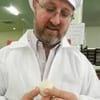Oral lesions not associated with Mycotoxins
Published: March 29, 2021
Source : Chris Morrow / Bioproperties, Ringwood, Australia.
Oral lesions in chickens can be caused by trichothecene mycotoxins (for example T2) but there are other causes including any contact toxins (CuSO4), excessive CuSO4 and physically rough forms of particulate Calcium. Mycotoxin binder salesmen regard oral lesions as pathognomic for lack of mycotoxin binder in the feed and diagnosticians always worry that a negative mycotoxin assay is a sampling artefact. This case study made me realize that oral lesions are not always associated with mycotoxins and that the negative assays are sometimes indicative of the mycotoxin situation. Also a handy rule of thumb is that unless it is a mycotoxin with reproductive effects that the category of stock most affected will be the ones ingesting the highest doses per kg–broilers.
Over a decade ago a broiler breeder farm in Thailand was having typical breeder feeding problems. They were on a corn-soy diet that was presented as an expanded pellet but the eating up time was very short during rearing and lay (See Figure 1). To increase the eating up time they decided not to extrude the mixed milled feed components from 8 weeks. Eating up time increased and in fact some feed was still left all day. Uniformity was terrible. In the shed when I suggested that the feed needed to be pelleted the manager complained that he had even more problems and reached down and showed me oral lesions in an 18 week old replacement pullet. I suggested (using the Anna Karenina syndrome principle) that this may be being caused by the farinaceous feed.
Visiting the farm again in at 22 weeks I was told that they had done an analysis and peak lesions were at peak feed allocation. Also delaying the feed form change to 15 weeks had greatly reduced the oral lesions. Assays for many mycotoxins had not revealed anything significant even taking into account synergistic effects. The T2 assay result was “not detected” in a test with the limit of detection being 50 µg/kg. There was no problem with broiler performance on an extruded pellet ration using largely the same raw materials. Histopathology characterized the lesions as Subacute/chronic stomatitis with buccal ulceration and erosion.
I had also found a reference to fine feeds causing oral lesions in an avian histopathology book1. An experimental study by Mike Gentle at Roslyn Institute2 had shown the propensity of finely ground feed to cause oral lesions (where the original pellets did not) and similarly peak lesions were at peak feed amounts. They hypothesised that particles in feed act like a toothbrush and clean the mouth.
Interestingly there were no lesions at the commissures of the beak (in contrast to proven T2 reports and dose studies) and no lesions in the crop or outside the mouth. After this case, I recognised many similar cases in South Africa, Hungary, and Russia. All had a history of oral lesions, floury feed, no demonstrable trichothecenes, no problems in birds on pelleted feeds from same raw materials and no lesions at the commissures of the beak. Some episodes had birds with tongue tip necrosis but not all. This may have a different aetiology.
Analysis of the feed showed increase fines on sieving compared to other mashes from Indonesia and UK.

This problem also interacted with heat (decreased feed consumption). Some pictures in some avian pathology atlases attribute the lesion to T2 or related compounds but don’t state that these compounds were found. Floury feeds have other problems including bridging in silos (this can be prevented by addition of 25% cracked corn).
There are other descriptions of oral lesions associated with finely ground feed in the literature including one from California3. Improvement of pellet quality is possible with pellet binders and raw material selection (for example in corn soy diets sorghum increases pellet hardness while in wheat based diets sorghum decreases pellet durability).
Presented at AVPA SCIENTIFIC MEETING 15th-16th February 2017 and published on http://www.bioproperties.com.au/.
1.- Goodwin M.A. (1996) Alimentary system, in Avian Histopathology Editor C Riddell, Second edition p112.
2.- Gentle MJ (1986) Aetiology of food-related oral lesions in chickens Research in Veterinary Science 40:219-224.
Gentle ML and FL Hill (1987) Oral lesions in the Chicken: Behavioural responses following nociceptive stimulation Physiology and Behaviour 40:781-783.
Gentle ML, MH Maxwell, LN Hunter, and E Seawright (1989) Haematological changes associated with foodrelated oral lesions in brown leghorn hens Avian Pathology 18:725-733.
3.- Daft B, Read D, Manzer M, Bickford A, & Kinde H. (2001). The influence of crumble and mash feed on oral lesions of white leghorn laying hens. Avian Dis. 2001 45:349-354.
Related topics:
Mentioned in this news release:
Bioproperties PTY Ltd
Recommend
Comment
Share

Would you like to discuss another topic? Create a new post to engage with experts in the community.













